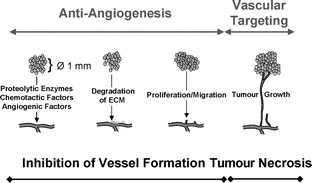Owing to morphological and rheological differences of the tumour vascular system as compared to the vascular system of the surrounding tissue, the efficacy of several experimental and clinical therapeutic approaches is limited. This fact has put the vascular system of solid tumours into focus and two new therapeutic strategies, anti-angiogenesis and vascular targeting, have emerged. Under the term vascular targeting various therapeutic approaches are summarized, e.g. chemoembolization, chemotherapy, hyperthermia, vascular targeting agents (VTA) and photodynamic therapy (PDT). As shown using the clinically approved photosensitiser Photofrin® the irreversible destruction of the tumour vascular system is primarily responsible for an effective PDT of solid tumours. However, the clinical disadvantages of Photofrin® are well known. Thus, several new photosensitisers, e.g. aminolaevulinic acid (ALA), porphycenes and indocyanine green (ICG), have been evaluated in vitro and in vivo regarding their suitability for vascular targeting of solid tumours. The promising experimental findings with the photosensitiser ICG led to first clinical results in treating Kaposi's sarcomas. In summary, systemic PDT is only effective when leading to complete ischaemia of solid tumours with subsequent necrosis. An essential prerequisite is the use of a chemically and photophysically defined photosensitiser localizing in the intravascular space due to e.g. a high molecular weight. The specific properties of such a photosensitiser are outlined.

You have access to this article
 Please wait while we load your content...
Something went wrong. Try again?
Please wait while we load your content...
Something went wrong. Try again?


 Please wait while we load your content...
Please wait while we load your content...